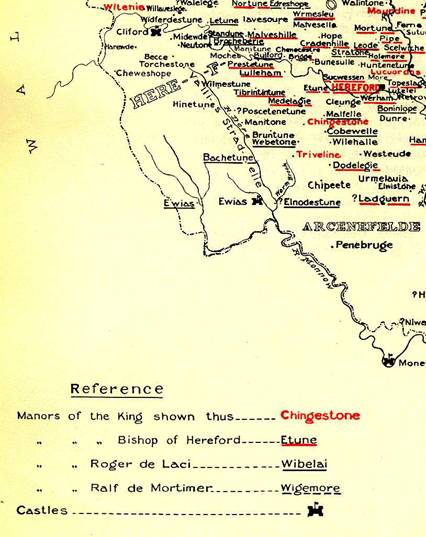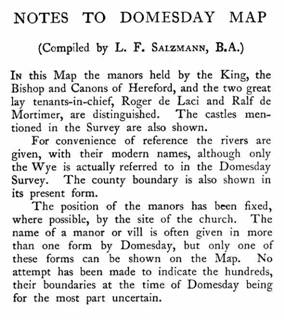Title: | The Land of Ewyas at the time of Domesday Book |
Date: | 1086 |
Ewyas in the Domesday Book
In 1066, the date in history that everyone knows, William the Duke of Normandy defeated King Harold at the battle of Hastings. By conquest he became the sovereign and legal owner of the whole of England. He wanted to know what land he had, who held it and what was due to the King. In the winter of 1085 at Gloucester, after speaking with his counsellors, he arranged to send men all over England, to every shire, and to find out what each landholder held, in land and livestock and what it was worth. The commissioners were to take evidence under oath from the Sheriff, from the barons, the Frenchmen, the priests and reeves and four Englishmen of each Hundred, all were sworn to verify the details. Any lands in dispute were to be reported. In 1086 the returns were gathered together at Winchester, corrected and abridged and copied into one volume that became known as the Domesday Book.
At the time of William’s conquest the established local boundary of the English realm was the valley of the Dore also known as Straddele. Here the English had established themselves on most of the right bank, but west of this Ewias remained economically and ecclesiastically Welsh and politically its conquest was incomplete. It was to become Ewyas Lacy but it was not until the Act of Union with Wales in 1536 that it became technically a Hundred.
As the map of Domesday entries in south west Herefordshire show, mentions of Ewyas are sparse, there being little dues to William at that time. Bacton and Ewyas Harold are however mentioned with the implication that they were then part of England.
|
|
Following the conquest William gave the castlery of Ewyas Harold along with other lands of English Herefordshire to Walter de Lacy; by 1086 these were held by his son Roger de Lacy. The only reference to what was to become Ewyas Lacy is in folio 184 which says “The same Roger has an estate called Ewias (Ewyas Lacy) on the borders of Ewias. This land does not belong to the jurisdiction of the castle nor to the hundred. From this land Roger has 15 sestiers of honey and 15 swine when the men are there and he has pleas over them”.
The map, note, and transcription of folio 184 are from: J Horace Round, Introduction to the Herefordshire Domesday in The Victoria History of the County of Hereford, volume 1, 1908.
Ref: gc_ewy_2004


